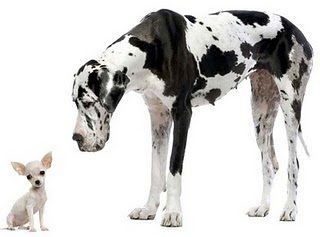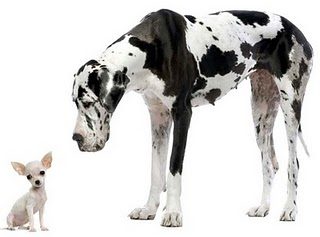

Big and Small: should they play together?
It is well known
that all dogs need socialization. Socialization is the term dog
trainers use for acclimating dogs to the world. This means safely
exposing your dog to sounds, smells, different surfaces, objects (canes,
walkers, wheelchairs, full shopping bags, hats), humans (tall, small,
old and young, black, white, yellow and brown), and other furry beings
(dogs, cats, horses etc.). Exposing your dog to the world where he will
live is the foundation of developing a confident and mentally healthy dog. This process is particularly important in the first months of a dog’s life, but continues for a lifetime. Often
it is an owner’s gut instinct to protect the life of the young puppy.
In some cases, it’s lucky for the puppy – who would gladly eat a pound
of cable wire, drywall and underwear in one sitting! In other circumstances however, this protection can be detrimental. In
an attempt to protect a dog or puppy – owners actually rob them of
opportunities to experience and acclimate to their own world and to
speak their own langauge with other dogs. I find this to be the case most often with puppy and small dog owners. I
often field the comment, "I don’t want my little dog around big dogs,"
or question, "do you allow small dogs to play with big dogs."
The generic "dogs under 25 pounds" rule
I
don’t like generic rules. I fully understand their business purposes in
lowering fluke accident liabilities, but I don’t think they work for
all dogs. What’s most important in dog play is not WHO they are playing with but HOW they are playing together. As
the owner of a boarding facility, if I only allowed all dogs under 25
lbs to play together, there would be some small malteses who felt
absolutely tortured by a few of my feisty terrier, French bulldog,
Boston guests. Likewise one of my particularly soft Aussie guests would feel utterly shocked and disgusted by a goofy lab. While
the packages of these dogs are nearly the same, play style and
temperament varies greatly from dog to dog, even amongst a breed and
litter. Of
course, there is a certain inherent risk when a giant breed Great Dane
plays with a teacup Chihuahua – but more than size – it’s the STYLE of
play that counts.
Doggie Style
Owners
must understand that unlike small children, dogs will never sit down
and play house, draw pictures side by side or talk politics. Dogs will
run, chase, wrestle, nip, bark and growl. These are all normal play
behaviours in dogs.
Small dog parents often wince, squeal, and
then run in and swoop up their small puppy or dog from another larger
playful puppy or adult dog. The ear and cheek mouthing, sing-song
growling, and wrestling looks intense and owners worry their puppy is
being hurt.
It is often the
case that they are not protecting their dog, rather they are taking away
the dog’s opportunity to "speak" for himself and robbing him of
developing the ability to tell other dogs, "I don’t want to play like
that," or even, "yes, game on, I love it when we wrestle like that!"
There are
certainly moments where you may need to step in – but it’s very
important to know WHEN you are helping your dog and when you are simply
blunting his ability to develop well round social skills.
When a nice group of well-socialized dogs are playing –
small and large dogs can mix. In fact, well socialized dogs are keenly
aware of how their body works (the level of contact they make, the
pressure they use with their mouth etc.) Happy-go-lucky
dog play looks rhythmic and flowing – racing, back and forth wrestling,
open mouth soft contact, sing-song type growling and small breaks in
play are all good signs. Intense play involves often goes vertical (dogs standing on hind legs often), a
lot of over the back neck grabbing (and holding), growling that is a
very quick deep vocal burst- maybe followed by an air snap, one dog may
be trying to get away repetitively.
How do I know if the play is normal when they are growling and biting?
If two dogs or puppies are playing – and you question whether they both are enjoying it – remove the dog or puppy that you think is "the bully." Simply call the dog out of play or gently hold his collar and escort him 3-5ft away from the other dog. If
the other dog happily follows or prances back to "the bully," clearly
the dogs are enjoying one another. Allow the play to continue. If the other dog does not come back to the "bully," simply try to divert their attention to other activities or playmates.
In dog play – it’s style more than the size that matters. Did I really just type that?
Warm wags,
Colleen
Join the newsletter and never miss out on dog content again!
"*" indicates required fields
By clicking the arrow, you agree to our web Terms of Use and Privacy & Cookie Policy. Easy unsubscribe links are provided in every email.